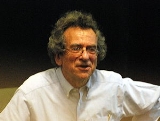
David Mermin
Encyclopedia
Nathaniel David Mermin is a solid-state physicist
at Cornell University
best known for the eponymous Mermin-Wagner theorem
and his application of the term "Boojum
" to superfluidity, and for the quote "Shut up and calculate!"
Together with Neil W. Ashcroft, Mermin has written an esteemed textbook, Solid State Physics, and numerous popularizations of physics and mathematics.
with two books and several articles. In Its About Time (2005) he suggests that the English foot be slightly modified:
This adaptation of a physical unit is one of several ploys that Mermin uses to draw students into space-time geometry.
Solid-state physics
Solid-state physics is the study of rigid matter, or solids, through methods such as quantum mechanics, crystallography, electromagnetism, and metallurgy. It is the largest branch of condensed matter physics. Solid-state physics studies how the large-scale properties of solid materials result from...
at Cornell University
Cornell University
Cornell University is an Ivy League university located in Ithaca, New York, United States. It is a private land-grant university, receiving annual funding from the State of New York for certain educational missions...
best known for the eponymous Mermin-Wagner theorem
Mermin-Wagner theorem
In quantum field theory and statistical mechanics, the Mermin–Wagner theorem states that continuous symmetries cannot be spontaneously broken at finite temperature in systems with sufficiently short-range interactions in dimensions d ≤ 2...
and his application of the term "Boojum
Boojum (superfluidity)
In the physics of superfluidity, a boojum is a geometric pattern on the surface of one of the phases of superfluid helium-3, whose motion can result in the decay of a supercurrent. A boojum can result from a monopole singularity in the bulk of the liquid being drawn to, and then "pinned" on a...
" to superfluidity, and for the quote "Shut up and calculate!"
Together with Neil W. Ashcroft, Mermin has written an esteemed textbook, Solid State Physics, and numerous popularizations of physics and mathematics.
Mermin’s foot
Mermin has contributed to special relativitySpecial relativity
Special relativity is the physical theory of measurement in an inertial frame of reference proposed in 1905 by Albert Einstein in the paper "On the Electrodynamics of Moving Bodies".It generalizes Galileo's...
with two books and several articles. In Its About Time (2005) he suggests that the English foot be slightly modified:
- Henceforth, by 1 foot we shall mean the distance light travels in a nanosecond. A foot, if you will, is a light nanosecond (and a nanosecond, even more nicely, can be viewed as a light foot). …If it offends you to redefine the foot … then you may define 0.299792458 meters to be 1 phoot, and think "phoot" (conveniently evocative of the Greek φωτος, "light") whenever you read "foot".
This adaptation of a physical unit is one of several ploys that Mermin uses to draw students into space-time geometry.
External links
- Mermin's homepage
- "What's wrong with those talks?" by David Mermin
- Mermin's festschrift in Foundations of PhysicsFoundations of PhysicsFoundations of Physics is a monthly journal "devoted to the conceptual bases and fundamental theories of modern physics and cosmology, emphasizing the logical, methodological, and philosophical premises of modern physical theories and procedures"...

